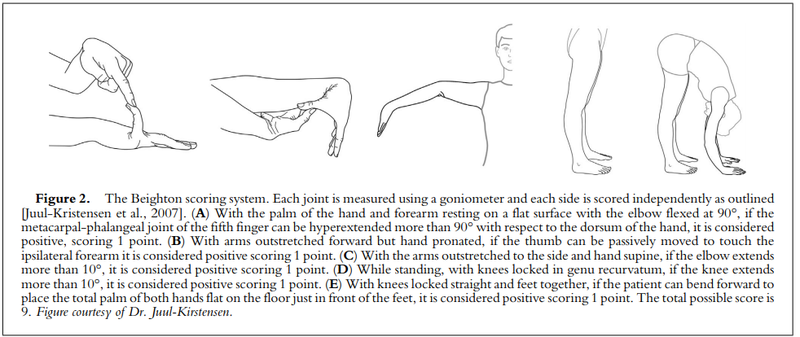Benign Joint Hypermobility Syndrome: Difference between revisions
mNo edit summary |
|||
| Line 12: | Line 12: | ||
== Diagnosis == | == Diagnosis == | ||
The diagnosis of Benign Joint Hypermobility Syndrome (BJHS) is made with the revised Brighton 1998 criteria.<ref name=":0" /> This should not to be confused with the Beighton score. Note should be made that the Beighton scoring method for assessing generalised hypermobility is thought to be flawed and has garnered some controversy. Some authors argue for a greater emphasis on clinician judgement.<ref>{{Special}} Malek, S., Reinhold, E.J. & Pearce, G.S. The Beighton Score as a measure of generalised joint hypermobility. ''Rheumatol Int'' 41, 1707–1716 (2021). https://doi.org/10.1007/s00296-021-04832-4</ref> | The diagnosis of Benign Joint Hypermobility Syndrome (BJHS) is made with the revised Brighton 1998 criteria.<ref name=":0" /> This should not to be confused with the Beighton score. Note should be made that the Beighton scoring method for assessing generalised hypermobility is thought to be flawed and has garnered some controversy. Some authors argue for a greater emphasis on clinician judgement.<ref>{{Special|1}}Malek, S., Reinhold, E.J. & Pearce, G.S. The Beighton Score as a measure of generalised joint hypermobility. ''Rheumatol Int'' 41, 1707–1716 (2021). https://doi.org/10.1007/s00296-021-04832-4</ref> | ||
* Major Criteria | * Major Criteria | ||
Revision as of 16:00, 8 March 2022
Hypermobility vs. Joint Hypermobility Syndrome
Joint hypermobility refers to ligamentous laxity where joints move beyond a range that is considered normal for the joint in the context of that persons demographics. Hypermobility is fairly common. This is especially so in younger people, women, and in those with Asian and African descent. Most hypermobile people are asymptomatic and don't have an underlying connective tissue disorder. The increased flexibility may theoretically provide an advantage in sport, dance, and music.
Joint hypermobility syndrome on the other hand is a heritable connective tissue disorder that is characterised by joint laxity with chronic pain, musculoskeletal dysfunction such as dislocations, chronic fatigue, dysautonomia, amongst other problems. It is difficult to differentiate between hypermobility with chronic pain and chronic pain in isolation. Many studies have shown that individuals with generalised joint hypermobility have an increased risk of chronic pain and fatigue, along with lower physical fitness, and higher psychological distress.[1]
Joint Hypermobility Syndrome vs. hypermobile Ehlers Danlos Syndrome
These two conditions are clinically indistinguishable. Neither has an objective diagnostic test or known molecular/genetic basis.
Benign Joint Hypermobility Syndrome (BJHS) is a condition that comes from the Rheumatology literature (Brighton Criteria).[2] It is thought by many to be the same condition as hypermobile Ehlers Danlos Syndrome, a condition that comes from the Genetics and Paediatrics literature (Villefranche criteria and 2017 New York criteria).
Diagnosis
The diagnosis of Benign Joint Hypermobility Syndrome (BJHS) is made with the revised Brighton 1998 criteria.[2] This should not to be confused with the Beighton score. Note should be made that the Beighton scoring method for assessing generalised hypermobility is thought to be flawed and has garnered some controversy. Some authors argue for a greater emphasis on clinician judgement.[3]
- Major Criteria
- Beighton score of ≥ 4 (either currently or historically)
- Arthalgia for longer than 3 months in 4 or more joints
- Minor Criteria
- Beighton score of 1, 2, or 3 (0, 1, 2, or 3 if aged over 50)
- Arthalgia (> 3 month duration) in one to three joints or back pain (> 3 month duration) or spondylosis, spondylolysis/spondylolisthesis
- Dislocation or subluxation in more than one joint, or in one joint on more than one occasion
- Three or more soft tissue lesions (eg, epicondylitis, tenosynovitis, bursitis)
- Marfanoid habitus: tall, slim, arm span greater than height >1.03 ratio, upper segment less than lower segment <0.89 ratio, arachnodactyly
- Skin striae, hyperextensibility, thin skin, or abnormal scarring
- Ocular signs: drooping eyelids, myopia, antimongoloid slant
- Varicose veins, hernia, or uterine or rectal prolapse
- Mitral valve prolapse
- Requirements for diagnosis are any one of the following:
- Criteria
- Two major criteria
- One major plus two minor criteria
- Four minor criteria
- Two minor criteria and unequivocally affected first-degree relative in family history
- Excluded by presence of Marfan or Ehlers-Danlos Syndrome (other than EDS Hypermobility Type as defined by Ghent 1996 or Villefrance 1998).
- Major 1 and Minor 1 are mutually exclusive, as are Major 2 and Minor 2.
- Criteria
References
Papers of particular interest have been highlighted as: ◆ of special interest ◆◆ of outstanding interest
- ↑ Scheper MC, de Vries JE, de Vos R, Verbunt J, Nollet F, Engelbert RH. Generalized joint hypermobility in professional dancers: a sign of talent or vulnerability? Rheumatology (Oxford). 2013 Apr;52(4):651-8. doi: 10.1093/rheumatology/kes220. Epub 2012 Aug 25. PMID: 22923760.
- ↑ 2.0 2.1 Grahame R, Bird HA, Child A. The revised (Brighton 1998) criteria for the diagnosis of benign joint hypermobility syndrome (BJHS). J Rheumatol. 2000 Jul;27(7):1777-9. PMID: 10914867.
- ↑ ◆ Malek, S., Reinhold, E.J. & Pearce, G.S. The Beighton Score as a measure of generalised joint hypermobility. Rheumatol Int 41, 1707–1716 (2021). https://doi.org/10.1007/s00296-021-04832-4


